“The need for collaboration is especially clear for water. Few things are so intimately linked with life and prosperity.” – Brandes, Marshall, and Sears
The biggest watershed new stories are usually about conflicts; lately in BC, this means mines and pipelines. People want jobs, but they also want BC to be beautiful. What’s the balance? In the spirit of Building Bridges, it was a pleasure to join forces with Oliver Brandes (of the Polis Institute), and David Marshall (from the Fraser Basin Council) on an op-ed for the Vancouver Sun, promoting watershed collaboration.
The article grew from a watershed gathering held in Vancouver in late January – a crash course on collaboration, and a chance to learn what other groups are doing in BC. Basically, we’ve all been going it alone, with little formal communication between the Island, the Fraser, the Columbia, the Okanagan, and other watersheds.
Our op-ed focused on collaboration as a principle for watershed management, but we purposely didn’t dig into watershed governance because it hasn’t been as well-defined in public conversation. My impression at the gathering was that governance means different things to different people. Here, I want to share my sense of the common threads.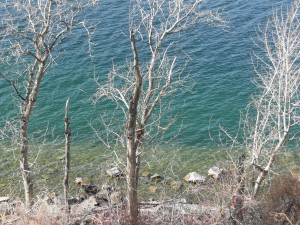
In a perfect world, environmental agencies would have lots of boots on the ground, and excellent data on natural resources and economics. They’d be making decisions that suit local needs and fund health care and education province-wide. Instead, the ministries are shrinking, we have pared-down budgets and high demand for raw materials. Yet we still need to protect water sources. We have to do more with less, and do more, regardless.
Government wants information from the local level, and locals want to participate – but we’re still working on the process of exchange: this is the nuts and bolts of watershed governance.
The word has a clunky ring, but the idea of governance is that there’s more to decisions than just someone, like George W. Bush, saying “I’m the decider.” Many times, the buck does stop with a statutory decision-maker, a provincial employee with big responsibilities. But even at the best of times it’s difficult to stand in judgment about who should get a water licence, or to tell a farmer to turn off his irrigation during a heat wave. My experience is that these “deciders,” make happier choices when they have better information, and are working with a supportive community.
Watersheds span borders and boundaries. This means that any given gravel pit can affect a water utility on a nearby creek, a municipality downstream with a lake intake, and fish spawning as far as a sediment spill will carry. A system of watershed governance can supply formal ways for those who aren’t statutory decision-makers to weigh in on where gravel pits are sited: providing advice and developing future plans.
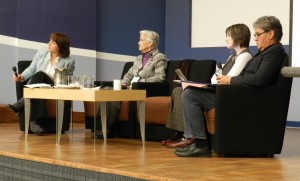
A panel on widening the circle of collaboration with the Honourable Iona Campagnolo, Merrell-Ann Phare, and Grand Chief Ed John.
Some of the controversy with the term “watershed governance” is whether it means there is a down-shift of authority to local control. One currently popular philosophy is that decisions should be made at the lowest appropriate level of government. But that leaves us hanging. “Which decisions should be made locally, and which should be made in Victoria or Ottawa?”
Most of what I’ve heard from local leaders is that they would like to have a say about polluting industries that affect a common resource, like water or air quality. Water licensing authority is less sought after. On one hand licences should be based on straight facts (is there enough water to support a new licence?), and on the other hand, licensing is notoriously prone to cronyism (it depends who you know). In general, local governments do not want a lot of new responsibilities, but they do want a say about resource development around them.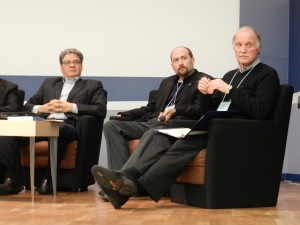
BC watershed organizations range from large and sophisticated (like the Fraser Basin Council or the Columbia Basin Trust), to small scattered groups of volunteers. The Okanagan Basin Water Board is somewhere in the middle: compact and durable. If we (collectively, BC) want local input to decisions, we have to find a way to support people from small rural areas. They tend to live nearest to the resource development, but don’t have many resources, themselves, to weigh in.
Under the new Water Sustainability Act, the province is considering whether to “enable” regions to form watershed agencies. In practice, this means government can leave a place holder in the new Act, and spend a few more years on the regulations. If we are revisiting the basic rules of the game, we should use this time to agree on the kinds of authority could be transferred, and on how to level the playing field.
A final governance question from the gathering is how government will move forward with the new Water Sustainability Act when there are so many unresolved questions about First Nations rights and title for water and resources. It’s painfully slow, watching the movement through the court system. In this, we need a decision soon.

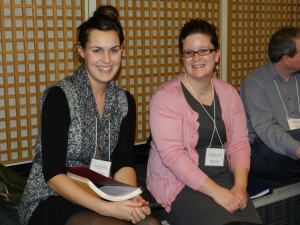
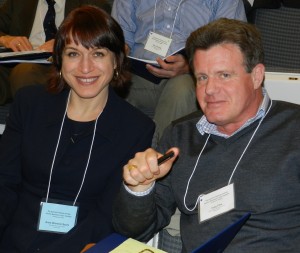

Hi Anna,
Informative piece. Liked understanding better the big and then the compact. Loved the “I’m the decider” comment. Glad you included rural B.C.
Holley
Hi Holley,
Thank you for your comment. Yes, rural BC has a whole different array of challenges than the larger urban centres. I watched the “I’m the decider” video clip, and GWB did say that he gets information from many sources before he makes his call.
Anna
An important post. There’s little doubt that collaboration is a key ingredient to durable solutions.
While not the focus of Dr. Sear’s post, the comment about getting used to “doing more with less” tweaked a nerve. I keep hearing this more and more over the past couple years. The idea that it is utopian for environmental agencies/groups to have sufficient resources to conduct good science because budgets are shrinking due to other important priorities such as education and health care. This sentiment got me to thinking about the subject of narratives and “narrative control”.
To be clear, I do not think for a moment that Dr. Sears is attempting to control any narrative on the subject of her post. Not for a moment. Rather, the comment about “doing more with less” caught my eye as something worth commenting about generally (….plus I don’t have my own blog). If the default narrative of “we have to do more with less” is to be accepted, the sphere of options and opportunities narrows alarmingly. Is it really the case that there’s just less, so get used to it? In a time of incredible challenges to sustainability, it’s an immensely important and far reaching assumption to consider. Before offering up some interesting further reading (to the one or two people that might see my comment!), a couple examples of narrative control in action, from the headlines.
I want to invite people to evaluate the fundamental tenets of the narrative, and decide whether it is even framed logically before engaging the narrator on their talking points. Does the narrative stand up to a good critical questioning? With regard to “doing more with less”, why do we have less? Does anyone “have more”? Who? Who benefits? Are those who benefit representative of the greater interest, both current and future generations? Do these benefits need to be more equitably redistributed? Etc. If the answers to these questions highlight systematic gaps and inequities, our first response should be to pressure for change rather than accept “less”.
Two pieces from The Guardian related to the business of climate change denial illuminate some key facts rarely addressed in the popular media. Check out George Monbiot’s blog “Why is it so easy to save the banks – but so hard to save the biosphere?” and Bill McKibben’s article “Why the energy industry is so invested in climate change denial”. These pieces provide a basis to think that at least in the energy sector, there’s no shortage of money to go around for natural resource stewardship. The problem isn’t “less,” the problem is that the “plenty of more” simply hasn’t been collected by governments or otherwise incentivized towards activities that science has been telling us for decades supports sustainable development. In our increasingly anti-democratic climate of “money = speech”, misdirected narratives (designed and paid for by special interests) is one of the culprits.
Narrative shapes opinion. Put a person in the context of a catchy phrase, a compelling narrative, “verbal theater” and watch how these stories/lines make their way into routine conversation. Shortly thereafter, people begin to walk in lockstep, often not even aware of it.
In the hurry to package everything into easy-to-understand terms, too few peer outside of the box, challenge underlying assumptions, ask questions, determine if the objectives served are appropriately broad, vet and fact-check.
Everyone has an opinion, but not everyone has a workable solution, let alone a point of view formed from an equal weight of evidence.
Hi Clint,
Quite a post! There are a lot of politics in there that I don’t want to wade into, but I’ll respond to the philosophical spirit of your comments.
I agree that the “Doing more with less” has a lot of underlying policy assumptions. I like to joke that when people use the term “innovative”, they mean “inexpensive”. My broader point is that we need to do more regardless of the amount of resources available. We have many resources – especially ideas, people, community – that we aren’t using to the full potential. Having limitations sometimes does inspire creativity and “innovation” – however you define it. Sometimes we can spend too much on technical solutions, when what we really need is a line of rocks along the hillside (see my post “Rocks, computers and other water tools for distributed networks”).
Anna
Hello Anna,
I enjoyed your comments about the Collaborative Watershed Governance Forum that you so kindly suggested I attend.
I agree that Collaborative Governance hasn’t been as well-defined in public conversation but meetings like this help. The forum was a great place for dialogue focused on real world examples by people who are on the ground not only in boots but also white collars. Changing the way we as a civil society think about our resources can start by asking simple questions. Here’s one for the supply-side – demand-side discussion, do I ‘own’ or ‘use’ the water coming from my tap?
I look forward to the dialogue.
Kathy
Great to hear from you Kathy. That is a good question. My next post that I am (too slowly) working on is about water re-use and recycling, which adds a further wrinkle. The general principle as I understand it is that the “crown” owns the water, but that we are licenced to use it: i.e., to wash with it, or water our yards, and return it to the water cycle. We explicitly can’t sell it (unless we have a bottled-water business, with special permission), and even where there are water markets (in Alberta, Australia, the western U.S. and elsewhere) the item being exchanged is the right to use it rather than the substance itself. Splitting hairs? Maybe.